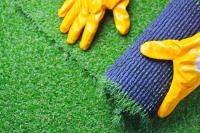 Add My Company
Add My Company
Sign In
How to Hide Joins in Artificial Grass
01-06-2021

Artificial grass is a big investment and, when installed correctly, it can completely transform the look of your garden. In the same way that fake grass can upgrade your outdoor space and make it look beautifully flush if installed poorly, it can make your garden look worse than before.
When you’ve spent equal amounts of time, money and effort on a new artificial lawn, the last thing you want is for it to look lumpy, bumpy and have gaps between the seams. Not only does it look like an eyesore, but it will be extremely difficult to fix, meaning you run the risk of having to fork out for a complete replacement, and that’s not ideal for anyone. On top of this, it can be dangerous and pose a trip hazard, making it all the more important to have level joins.
How to Avoid Visible Joins in Artificial Grass
There is one obvious way to avoid having identifiable joins in your artificial grass, and that’s to have it installed by our professional team. Our service is comprehensive and means you don’t need to do any of the hard work. We will remove your existing turf and dispose of it, and we will use our two decades of experience to install your synthetic lawn perfectly. Not only will it lay completely flat and be flush against other areas of your garden, but there will no unsightly gaps or joins that ruin the overall aesthetic.
Whilst we always recommend our installation service, we realise that some of our customers prefer to be more hands-on and want to lay their fake lawn themselves. There’s nothing wrong with this; it’s actually quite common, and that’s we have made a full DIY installation guide.
Generally speaking, the process is relatively straightforward and painless, but joins are where most people experience difficulties.
How to Hide Joins in Artificial Grass
When you’ve removed your existing turf, laid a subbase, fitted a weed membrane and cut your lawn to size, you’re ready to start laying it.
Grain Direction
The first step of hiding joins is to make sure the grain is facing the same way. This means you need to look at the direction the grass is facing. If you lay two pieces of lawn and the grains do not match, you will instantly be able to see that you have laid two pieces of grass and your lawn won’t look seamless or flush.
Preparing the Edge and Positioning
Once you’ve established your grain direction, you will then want to begin the process of removing the manufacturing edge strip from both pieces of lawn. As well as removing the strip (which may or may not be present), you’ll also want to remove another couple of stitches, cutting as close to the stitch as you can (removing as much backing as possible). This will take away the bulk of the backing at the edge of the lawn and allow the two sections to sit flush next to each other.
When positioning the two pieces together, you will want to aim for the gap between the two pieces to be the same as the stitch gauge (the gap between the stiches of the grass itself). Once you think you have the pieces spaced perfectly, go along the whole join and check the spacing is as perfect as it can be before you move on to the next step. Be careful not to move the grass once you have it spaced correctly; sometimes it helps to spread a few bags of sand or use fixing pins to hold them in place.
Jointing Tape
Jointing tape is what will bind two sections of lawn together, so it’s important you position it perfectly. The two pieces of lawn carpet should meet together in the middle. There will be a rough side and a smooth side. You need to place the tape so that the smooth (green) side is facing down and the rough (white) side is on the top. You may wish to secure the tape with nails to prevent it from moving when you apply adhesive.
When it comes to applying the adhesive, you will need to fold the grass back first. It may need some weight to prevent it from folding back. It is important to double-check the two pieces line up perfectly before adding the glue as it is difficult to adjust once the glue is down. As far as the adhesive is concerned, make sure you lay it in a zig-zag motion on the rough side of the tape. When its cold (<5 degrees centigrade) warm the glue slightly by leaving it in sunlight or some slightly warm water to make the glue a bit easier to apply.
Fix the Lawn
Whilst the adhesive is still wet, you will need to fold the grass back over. It’s best to have two people to do this otherwise you run the risk of the lawn heavily impacting against the adhesive and causing a mess. It’s best if one person stands in front and holds the grass to preventing it from folding, and the other person stands behind them butting the two pieces together carefully to ensure the spacing is perfect as they move down the join.
Weight the Seam
The final step to keeping seams looking flawless is to walk down the seam to ensure a good contact between the adhesive, tape and the pieces of grass. You can even weigh down the seam until the adhesive has dried. This will prevent movement and ensure the edges blend together. It can take up to 24 hours to cure, even when the weather is hot, so it’s important to be patient whilst the glue dries.
It’s important not to rush any aspect of the jointing process. The more time and care you put into it, the better the results will be.
Request an Installation Quote
If you’re not confident in your ability to complete a DIY installation, we’re on hand to help. We install fake grass across the Greater London area, so if you live within our catchment radius, we will be able to professionally lay your artificial turf for you.
You can request an installation quote online and our team will get back to you. If you want to find out more about our artificial grass range or the installation process, or for clarification on our DIY instructions for those outside our catchment area, please contact us.
For more information on How to Hide Joins in Artificial Grass talk to Artificial Lawn Company
Enquire Now
List your company on FindTheNeedle.
